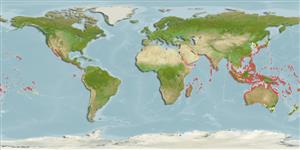Bryopsidophyceae |
Bryopsidales |
Codiaceae
Environment: milieu / climate zone / depth range / distribution range
Ecology
Epiphytic. Tropical
Indian Ocean: from Egypt to Mozambique, including the Red Sea, Seychelles, Madagascar, Mauritius, Réunion, Rodrigues and Mascarene Islands, east to India and south to Dampier, Western Australia, including Andaman Sea, Laccadive Islands, Maldives, Sri Lanka and Nicobar Islands; Pacific Ocean: from China to the south China Sea, south to New Zealand, including Federated States of Micronesia, Fiji, Norfolk Islands, the Great Barrier Reef, Lord Howe Island, Tasmania and French Polynesia, east to Chile, including Samoan Archipelago and Hawaiian Islands.
Length at first maturity / Size / Weight / Age
Maturity: Lm ? range ? - ? cm
Thallus forming a dark green, amorphous to convoluted spongy mass, composed of central medulla and cortex. Medulla consisting of branched cylindrical filaments, their tips inflated into cylindrical to clavate utricles forming the cortex.Hairs or hair scars occur in 1 to 3 vertical rows, at some distance from the tip of the utricle. Gametangia cylindrical and tapering towards both ends, borne at the side of the proximal portion of the utricle. Amorphous clumps up to 5 cm in diameter (Ref. 80758).
Used for human consumption and as medicine (Ref. 80758). Inhabits lower intertidal to shallow subtidal areas where it grows encrusted on sandy-rocky substrate or epiphytic on stipes of larger seaweeds and midribs of the seagrass Enhalus (Ref. 80758).
Life cycle and mating behavior
Maturity | Reproduction | Spawning | Eggs | Fecundity | Larvae
Guiry, M.D. and G.M. Guiry 2009 AlgaeBase. World-wide electronic publication, National University of Ireland, Galway. http://www.algaebase.org; searched on 14 April 2009. (Ref. 80701)
IUCN Red List Status
(Ref. 130435: Version 2025-1)
CITES status (Ref. 108899)
Not Evaluated
Not Evaluated
Threat to humans
Human uses
Fisheries: commercial
| FishSource |
Tools
More information
Trophic EcologyFood items (preys)
Diet composition
Food consumption
Predators
Population dynamicsGrowthMax. ages / sizesLength-weight rel.Length-length rel.Length-frequenciesMass conversionAbundance Life cycleReproduction
Maturity
Fecundity
Spawning
Eggs
Egg development
Larvae
PhysiologyOxygen consumption
Human RelatedStamps, coins, misc.
Internet sources
Estimates based on models
Preferred temperature
(Ref.
115969): 24.6 - 29.3, mean 28.4 (based on 2952 cells).
